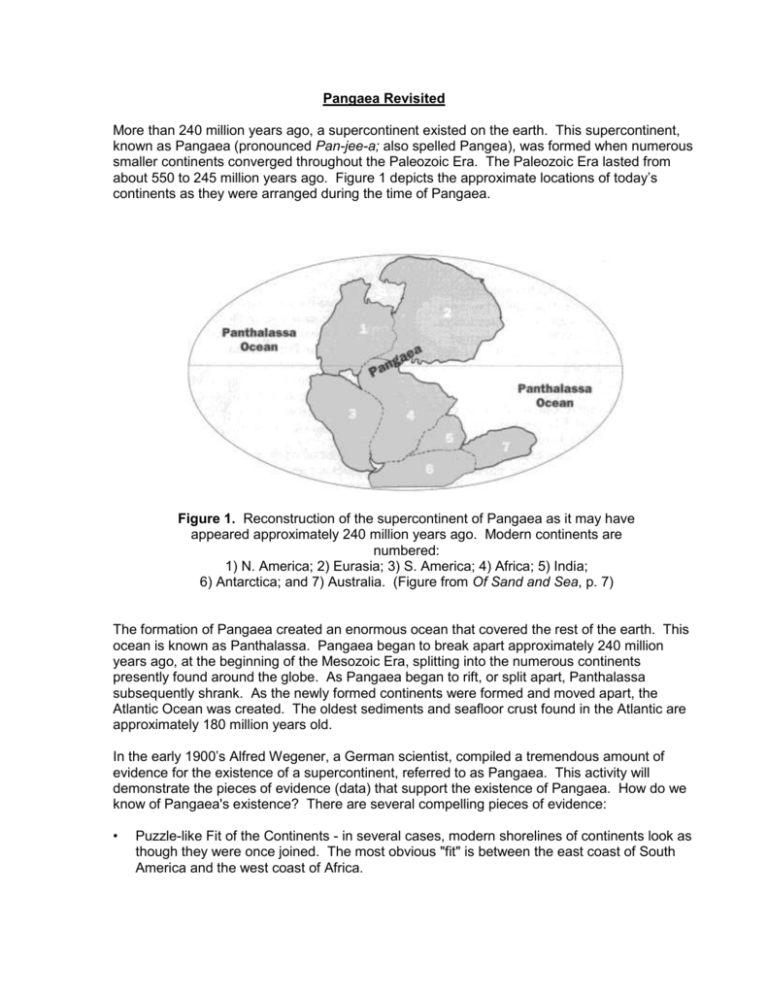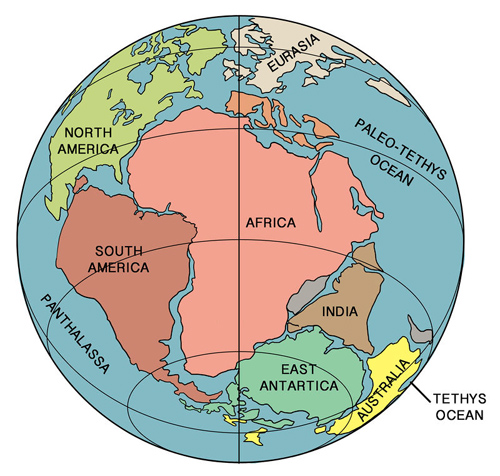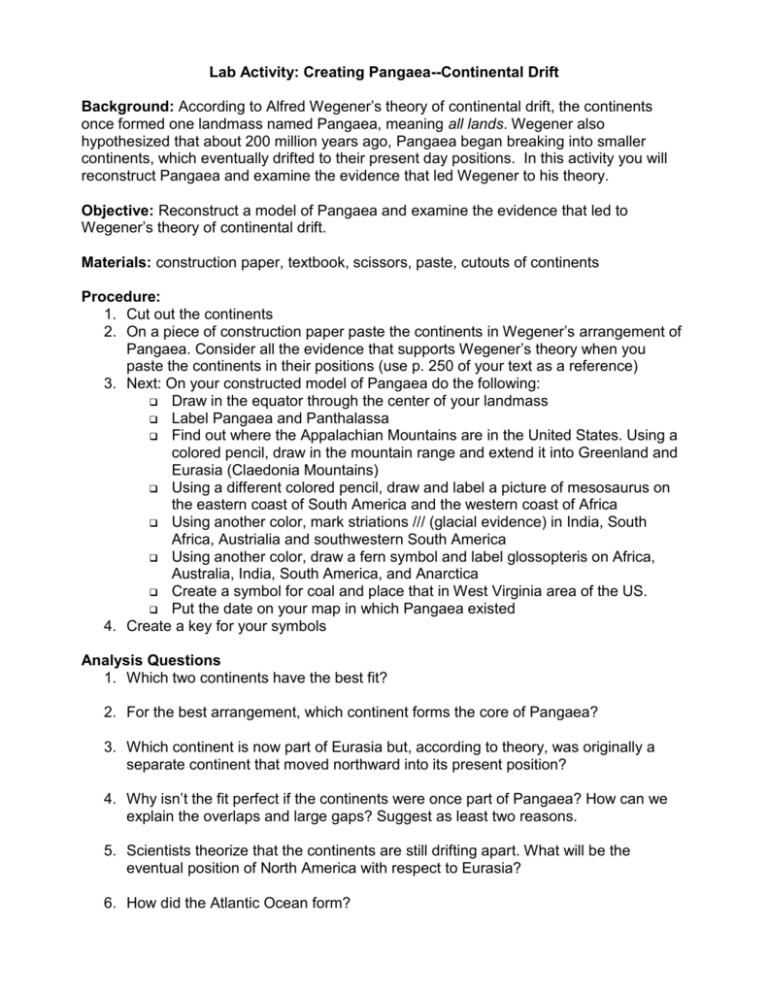Describe the Evidence Wegener Used to Reconstruct Pangaea
Pangaea means all lands According to Wegener Pangaea existed about 300 million years ago. Fossils have been found on all the southern continents Australia Antarctica India.

Pangaea Revisited Student Copy
The glacial deposits 3.

. Wegener also used continental drift to explain evidence. What pieces of evidence did Wegener use to reconstruct Pangaea. Although Alfred Wegener was not the first to suggest that continents have moved about the Earth his presentation of carefully compiled evidence for continental drift inspired decades of scientific debate.
He believed that Pangaea originated near the south pole and that the centrifugal force of the planet caused the protocontinent to break apart and the resultant continents to drift towards the equator. Alfred Wegener collected diverse pieces of evidence to support his theory including geological fit and fossil evidence. The theory encompasses the concepts of continental drift developed by Alfred Wegener and seafloor spreading.
Just as Wegener did when attempting to reconstruct Pangaea before modern oceanography. To explain this Wegener hypothesized that Spitsbergen drifted from tropical regions to the arctic. Up to 24 cash back LAB.
The misconception that Alfred Wegener used the modern-day coastlines for his reconstruction of Pangea has been propagated from his day to the present. Plate tectonics model describes the large scale motions of Earth s lithosphere. The Pangaea is known as supercontinent.
A number of lines of evidence indicate that Pangaea was not the original configuration of the continents. Wegeners idea that the continents slowly moved over Earths surface became known as continental drift. Wegeners evidence in concert with compelling evidence provided by post World War II.
Fossils and geologic evidence show that most of the continents used to have startlingly different climates than they do today. Fossils glacial deposits shapes of the continents and mountain ranges in their explanations. Mountain chains on cut-out pieces of the continent the student should be able to reconstruct a model of the supercontinent Pangaea by placing five of the seven.
Wegener relied on the work of Austrian geologist Eduard Suess who although he was a big proponent of the existence of sinking continents first developed the concept of Gondwanalanda supercontinent lasting from 600 million to 180 million years ago and made up of present-day Africa South America Australia India and Antarctica. For example fossils of warm-weather plants were found on the island of Spitsbergen in the Arctic Ocean. The breakup began about 195 million years ago in the early Jurassic period when the Central Atlantic Ocean opened.
Modern reconstruction of Pangaea Wegeners Pangaea redrawn from his book published in 1915. Up to 24 cash back Climate CluesWegener used continental drift to explain evidence of changing climates. Evidences are - 1.
The fossil evidence 2. SOLUTION- Question1 Alfred Wegener described the movement of continent to their present position through some evidences. Wegener thought continental drift was the key to these climatic puzzles so he and Vladimir Koppen plotted ancient deserts jungles and ice sheets on paleogeographic maps based on Wegeners theory.
Up to 24 cash back In the early 1900s Alfred Wegener collected a lot of evidence to support his theory about the supercontinent Pangaea. Wegener also used continental drift to explain evidence of. This was the time when reptiles and winged.
He believed that millions of years ago the continents were joined into a single land mass. He was German scientist. Wegener himself did not collect the fossils but he called attention to the idea of using these scientific doc uments stating there.
Plate tectonics also postulates that the continents joined with one another and broke apart several times in Earths geologic history. The pattern of seafloor spreading indicates that Pangea did not break apart all at once but rather fragmented in distinct stages. Pangaea broke up in several phases between 195 million and 170 million years ago.
The true polar wander component is identical for all samples and can be removed leaving geologists with the portion of this motion that shows continental drift and can be used to help reconstruct earlier continental positions. Plate tectonics has been rigorously tested from numerous sub disciplines in geology. 2matching geologic units rock types structure 3fossil evidence mesosour a freshwater reptile.
The jigsaw fit 4. The puzzle-like fit of the continents identical fossils found on continents. After Pangaea was accepted scientists had excited a new stir by assembling geological evidence of prior supercontinents.
1the continents seemed to fit. First Kenorland which would have broken up some 24 billion years ago. Climate CluesWegener used continental drift to explain evidence of changing climates.
Given the locations of fossils glacial deposits and. 2 Reconstructions of Pangaea The supercontinent of Pangaea as it is thought to have formed in the late Paleozoic and early Mesozoic eras more than 200 million years ago. Jigsaw fit- If we notice we see that View the full answer.
A letter written by Wegener to his wife in 1911 demonstrates unequivocally that even before he first began to formulate the hypothesis of continental drift Wegener did not consider fitting the continents at. The tectonic fit 5. The existence of the supercontinent Pangaea was first evidenced by the fit of continents namely Africa and South America which led to the hypothesis of continental drift Alfred Wegeners.
To explain this Wegener hypothesized that Spitsbergen drifted from tropical regions to the arctic. Listexplain the 4 lines of evidence Alfred Wegener used to support his continental drift hypothesis. Glossopteris ferns had very heavy seeds that could not move by wind or drift on ocean currents.
Evidence from fossilized organisms and mountain chains can be used to reconstruct the positions of todays continents and landmasses to form the supercontinent Pangea. Most geologists accept these tests as verification of plate tectonics. Wegener eventually proposed a mechanism for continental drift that focused on his assertion that the rotation of the earth created a centrifugal force towards the equator.
The continuity of mountain chains provides further evidence for Pangaea. It is important to know that the following specific fossil evidence was not brought up by Wegener to support his theory. For example fossils of warm-weather plants were found on the island of Spitsbergen in the Arctic Ocean.
Some of the evidence he collected included the following. According to Wegener the continents drifted together to form the supercontinent Pangaea pan JEE uh.

Evidence To Prove That Pangaea Had Existed Evidence Of Continental Drift Pangaea

Warm Up Warm Up Read The Using Evidence To Reconstruct Pangaea Worksheet Today S Goal Today S Goal What Does Pangaea Teach Us About The Lithosphere Ppt Download

No comments for "Describe the Evidence Wegener Used to Reconstruct Pangaea"
Post a Comment